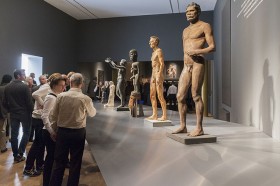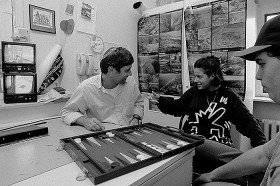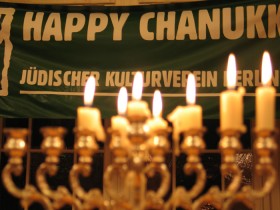I’m not sure what time it is, but it’s already light out. My alarm clock will go off soon. My eyes are already open – the sky is its usual grey. In the space behind my eyes, arguments are going around and around – legal, religious, social, and medical. My tongue doesn’t move but my thoughts speak all the lines of this drama. Right now I’m going around and around on the hamster wheel of an argument that I got dragged into on a tour I gave the day before of the special exhibition “Snip it! Stances on Circumcision.” Every time I thought I had explained to this visitor the profound differences between ritual circumcision of boys and female genital mutilation, she would bring us back into an argumentative spiral.

Visitors in the exhibition room “On the Knife’s Edge” © JMB, Foto: Jule Roehr
Despite Cilly Kugelmann’s assertion (see the German-language introduction of the book publication, downloadable on our website) that we don’t want to use “Snip it!” to continue the 2012 debate about ritual circumcision; despite an exhibition that addresses, above all, the cultural and historical background of the ritual; despite my careful presentation in the tours, where I aim to encourage visitors to really see and understand, and not to judge and argue; despite the many visitors who embrace my suggestions with great openness and interest: → continue reading
Complementing our special exhibit, “Snip It! Stances on ritual circumcision”, our blogger team went looking for Jews and Muslims who could speak on the topic from a very personal perspective, whether for or against circumcising their sons. We called upon our networks of friends and acquaintances and received a range of responses in return. Some made us smile; others, like this one about David, gave us pause. It is retold to us by Shlomit Tulgan, our colleague in the education department who knows him from childhood:

Shlomit met David in the Jewish Culture Center in Berlin
On this photo you see a tutor of the Berlin Jewish Community’s youth center on Joachimstalerstr playing Backgammon with kids, Berlin 1992 © Photo: Michael Kerstgens, Jewish Museum Berlin
David was born to a secular Jewish mother and, at 22, chose to be circumcised in Berlin’s Jewish Hospital. His reason was to “get back to his roots and regain what his parents had denied him.” David was no “sad child,” remembers Shlomit, who met him most of all at the Berlin Jewish Community’s youth center on Joachimstalerstr. Seemingly every month he was in love with another Jewish girl, and he was popular among the opposite sex despite his nature to move swiftly from one to the next. The youth center was particularly supportive when the circumcision was performed. Recovering in a hospital bed, David’s Lebanese flatmate and friend → continue reading

Hanukkah Candleholder at the 15th Hanukkah Ball of the Jewish Cultural Center, Berlin 12.12.2004 © Photo: Igor Chalmiev, gift of the Jewish Cultural Center to the Jewish Museum Berlin
25 years ago today, on 22 January, 1990, the Jewish Cultural Center was founded. One month earlier, on 13 December, 1989, the press agency ADN published an appeal in numerous East German newspapers. It announced a new coalition of Jews living in East Germany who were committed to spreading the knowledge of Jewish culture and history. The appeal was not an accident:
As early as 1986, secular Jews had found themselves gathering, at the invitation of the Jewish Congregation of (East) Berlin, to explore their Jewish roots – a heritage that no longer played any role in their parents’ identities. A group called “We for us – Jews for Jews” formed out of this second generation of political emigrants who had returned to Germany and grown up in the East. During their regular meetings → continue reading


